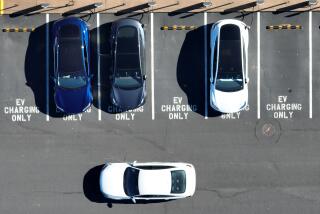California Off Final List of Collider Site Choices
- Share via
WASHINGTON — Energy Secretary John S. Herrington on Tuesday formally adopted a list of “best qualified” sites in seven states for a proposed $4.4-billion atom smasher, marking California’s final elimination from the quest for the nation’s largest civilian scientific project.
In a news conference, Herrington said the Energy Department had accepted the recommendations of a panel of the national academies of sciences and engineering, which last month singled out what it said were the most favorable sites in Arizona, Colorado, Illinois, Michigan, North Carolina, Tennessee, Texas and New York for the superconducting super collider.
To be completed in 1996, the project offers the winning state a bonanza of $270 million a year in operating funds, 2,500 permanent jobs and a magnet for high-technology firms.
New York Gov. Mario M. Cuomo withdrew a site near Rochester from contention Jan. 15 amid mounting local opposition to a commitment of about 16,000 acres to the project. At the same time, Govs. George Deukmejian of California and Richard Celeste of Ohio appealed for reconsideration of sites in their states.
Praises Academies
Herrington praised the two national academies for their “fairness and objectivity” in winnowing out what 21 experts considered to be the best sites among 35 proposed last year by 25 states. He said that Energy Department officials now will begin meeting with states eliminated from the running, on the assumption that they will want to know why they lost out.
But he emphasized that no sites will be added to the current list of seven.
“This is it,” Herrington said. “The department found no justification for either rejecting or changing the academies’ recommended list of states, which . . . was developed impartially, without bias.”
He said that he will resist political pressures “to the best of my ability” between now and next July, when the Energy Department is to pick a single preferred site from the seven semifinalists, which are essentially interchangeable on their technical merits, according to scientists on the academies’ site selection panel.
In Sacramento, Gov. Deukmejian charged through a spokesman that the site selection process was “unfair.”
“Neither the Academy of Sciences nor the Department of Energy even considered California’s economic package (of incentives),” said gubernatorial Press Secretary Kevin Brett. Noting that geological problems were given as a reason for rejecting California’s bid, Brett said the state’s proposal contained funds to resolve those problems. “It makes no sense for the Department of Energy not to consider that California has the resources to mitigate those difficulties,” he said.
“The governor certainly is displeased that after he walked the extra mile, after California placed before the Department of Energy a $560-million revenue bond, that it wasn’t even considered,” the spokesman said.
Brett added that “the governor presently is considering the possibility of filing a claim with the Department of Energy to recover the expenses that California incurred in developing the economic package.” He estimated that the University of California spent $2.5 million in developing California’s bid.
Financing Problem
A serious political problem facing the super collider, congressional staff members said Tuesday, will be keeping support alive in Congress for such a costly research project in a time of federal budget cuts, especially now that states that swing the greatest political weight are out of the running.
The super collider’s backers in the research community note that until now, state and congressional enthusiasm appears to have been fired more by the promise of a huge public works project than by the super collider’s abstract merits as a new window on the basic relation between matter and energy.
Despite the lure of dollars and jobs, the Reagan Administration failed to win congressional approval for $10 million in construction funds in the current fiscal year, and the prospects are not bright for obtaining more than $300 million the Energy Department has said it will request for fiscal 1989.
More to Read
Sign up for Essential California
The most important California stories and recommendations in your inbox every morning.
You may occasionally receive promotional content from the Los Angeles Times.













